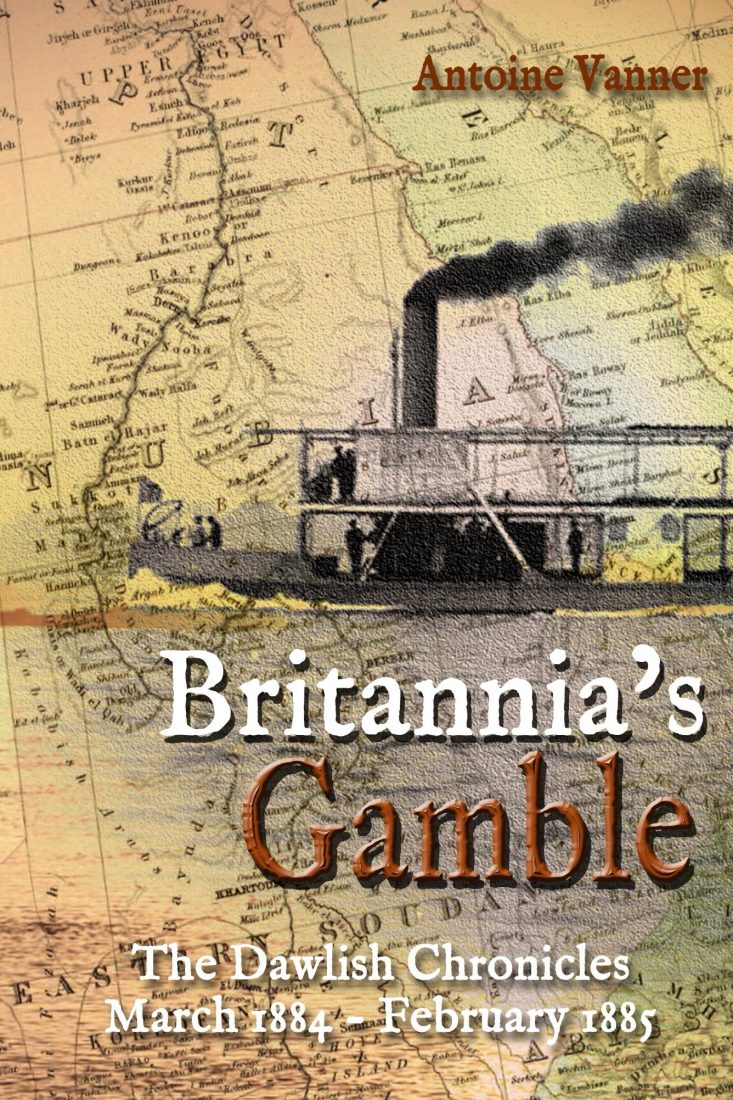HMS Calliope at Apia 1889
Cyclone, Pride, Folly and Brilliant Seamanship
In 1889 United States and German naval units were eyeing each other in an armed confrontation which Britain, represented by the screw corvette HMS Calliope, watched as a neutral but cautious observer. A false move by any party could well have triggered a shooting war with immeasurable historical consequences. The United States, up to then underestimated as an emerging Great Power, and the newly established German Empire – dating only from 1871 – were both taking their first steps towards projection of military and naval, as well as commercial, influence on a global scale. As new players, both were conscious – perhaps over conscious – of the importance of prestige. The scene of the confrontation was an unlikely one – the harbour of Apia on the northern coast of the Pacific island of East Samoa.

HMS Calliope – the heroine of Apia
A civil war had been in progress since 1886 – and indeed was to drag on to 1894 – and it involved a struggle between two Samoan factions for control of the Samoan Islands. German trading and plantation companies already had significant commercial interests in copra and cocoa-bean processing, competing in the process with American traders. Almost inevitably, Germans and Americans found themselves backing different Samoan factions and Britain too, though to a lesser extent, had a business presence. Tensions heightened in 1887 when a German naval vessel, ostensibly sent to protect German commercial interests, shelled a village in which American-owned property was destroyed – thereby resulting in despatch of an American naval force to protect American interests. The situation worsened the following year when one Samoan faction inflicted casualties on a German landing-party and destroyed German-owned plantations.
National pride was now at stake – the more so in view of the growing self-confidence of the newly- emerging powers of Germany and the United States. German, American and British naval units were despatched to Samoa and by March 1889 were moored in Apia harbour, each waiting for the other to make a move. Suspicion was greatest between the German and Americans. The British maintained a position of neutral observers. Annexation by either Germany or the US was a distinct possibility and national prestige was at stake – to what now seems a ludicrous extent. One more incident involving the rival Samoan groups, an incident likely to be outside the control of the foreign forces, could have been enough to shift the situation from armed confrontation to outright war between the German and American naval units.

SMS Olga – the largest German vessel present at Apia March 1889
The German force present at Apia consisted of three ships: the 2,424-ton corvette SMS Olga, the1,040-ton gunboat SMS Adler and the 760-ton gunboat SMS Eber. Though the Olga was the largest and most powerfully armed of these ships, the commander of the German force was Fregattenkapitän Fritze of the Adler.And it was at this moment – on 15 March 1889 – that a hitherto unexpected player, Nature itself, dealt the deciding hand. In the process death and disgrace were to be visited on some of those involved while another was to earn universal admiration for a spectacular feat of seamanship.
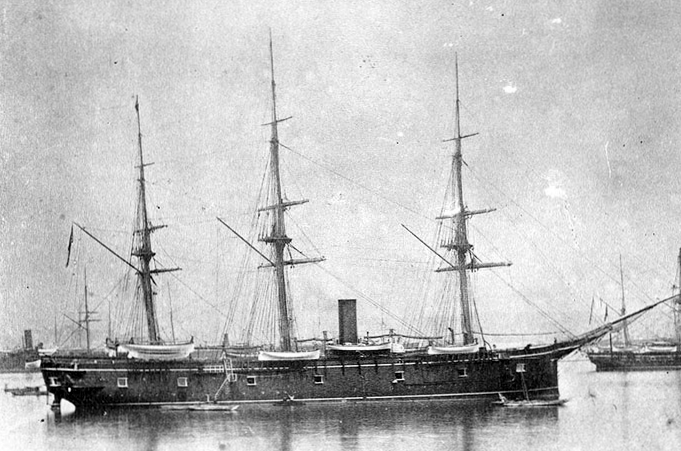
The USS Trenton – flagship of the US Pacific Station
The United States was also represented by three units. The flagship was the USS Trenton, A 3,900 frigate, the largest US warship built between the Civil War and the “New Navy” era that commenced in 1883. She flew the flag of Rear Admiral Lewis Ashfield Kimberly, and was commanded by Captain Norman von H. Farquhar. The second American ship was the USS Vandalia, a 2,033-ton sloop, notable for having carried former President Ulysses S. Grant on a tour of the Mediterranean in 1877/78. The smallest of the three ships was the USS Nipsic, a 1,375-ton gunboat.
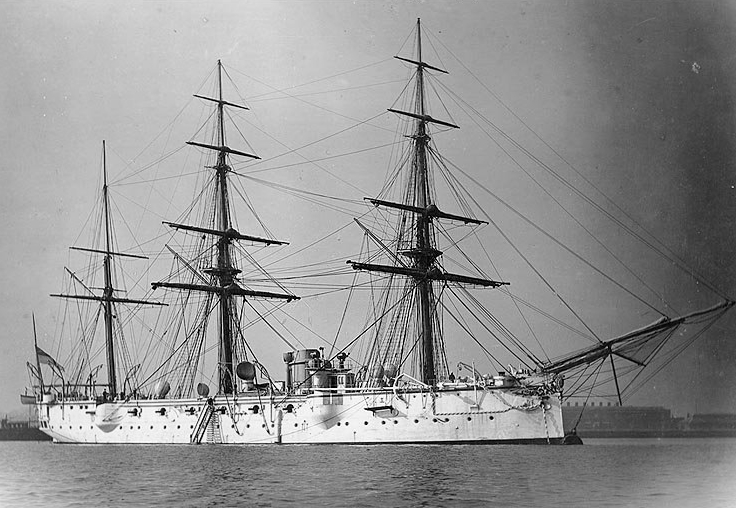
HMS Calliope – superbly designed and brilliantly commanded
 The Royal Navy’s single vessel, the 2,770 ton screw corvette HMS Calliope, launched in 1884, though not the largest, was the most modern present, being built of steel. She and her sister HMS Calypso have been described as “probably the most successful design of cruising ship” of their time and were intended from the outset for service in Pacific and Australian waters. Like the German and American ships she carried masts and sails to complement her steam-power so as to allow less dependence on sources of fuel on remote stations. HMS Calliope was commanded by Captain Henry C. Kane, a 46-year old officer who had already distinguished himself in action on land in Egypt in 1882. His background was interesting – the son of the eminent Irish research chemist, Sir Robert Kane, who was the only Catholic member of the “Irish Relief Commissioners” board that investigated the causes and possible solutions to the Irish Potato Blight in the 1850s. His mother was a noted botanist and author in her own right.
The Royal Navy’s single vessel, the 2,770 ton screw corvette HMS Calliope, launched in 1884, though not the largest, was the most modern present, being built of steel. She and her sister HMS Calypso have been described as “probably the most successful design of cruising ship” of their time and were intended from the outset for service in Pacific and Australian waters. Like the German and American ships she carried masts and sails to complement her steam-power so as to allow less dependence on sources of fuel on remote stations. HMS Calliope was commanded by Captain Henry C. Kane, a 46-year old officer who had already distinguished himself in action on land in Egypt in 1882. His background was interesting – the son of the eminent Irish research chemist, Sir Robert Kane, who was the only Catholic member of the “Irish Relief Commissioners” board that investigated the causes and possible solutions to the Irish Potato Blight in the 1850s. His mother was a noted botanist and author in her own right.
Apia is an exposed harbour, open to the Pacific and unprotected by high ground or an enclosing reef, and vulnerable to storms rolling in from the north. For several days prior to March 15th there were increasing signs – including falling atmospheric pressure – that a cyclone was approaching. This was indeed the cyclone season and Apia had been hit by one three years earlier, about which captains of the naval vessels present could learn from the locals. In all cases these commanders had seafaring experience in the Pacific and all saw the approach of potential disaster that could only be avoided by taking their ships from the harbour to ride out the likely 100 mph winds in the open sea.
And yet, as if they were players in some bizarre game of “Chicken”, no commander ordered such a move. Considerations of “face” were involved and no one was willing to admit, in front of the other nations’ navies, that they were afraid of the elements. Worse still, they refused to allow the thirteen merchant ships they were allegedly protecting to move either.
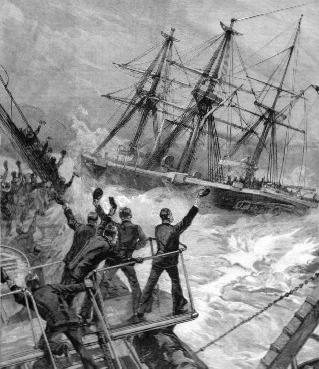
HMS Calliope’s escape, cheered from USS Trenton
The cyclone struck in the early hours of March 15th. Samoans onshore had already taken shelter but out in the harbour the ships were exposed to the full fury of wind and wave. The American and German commanders stuck by their decisions to remain at anchor and only Kane of the Calliope had the moral courage to disregard considerations of pride and to head for the open sea. Engines straining, and making less than one knot against the oncoming wind and sea, Calliope crawled northwards to safety through the narrow approach channel , despite being less than six feet from a reef at one point. Once at sea she was easily able to ride out the ensuing winds. Kane’s bringing of Calliope to safety was rightly regarded thereafter, and rightly so, as an outstanding act of seamanship.
Back in the harbour the USS Trenton’s moorings failed in the afternoon and she was flung against the beach, then dragged back into the sea until being finally wrecked on a reef at 10 p.m. that evening. The majority of her crew did however survive unhurt and were able to participate in the ensuing rescue operations for personnel of other vessels. The USS Vandalia was thrown on to the same reef in the early afternoon. Her crew was to spend some 24 hours night clinging to her rigging, losing 43 men before rescue was possible. The gunboat USS Nipsic was thrown high on the beach with the loss of eight men.

A contemporary drawing, showing the USS Trenton dragging her moorings
The German vessels fared even worse. The SMS Olga was flung onto the beach but many of her crew escaped higher ground. The Adler and SMS Eber were smashed together. The Eber had touched her propeller the reef in a storm some weeks earlier and the damage had impaired engine capability. Her commander, a Kapitan Wallis, recognising this weakness even before the cyclone hit, he had repeatedly requested permission to leave the harbour. This was refused by his superior, Fritze, on the Adler. Eber used her engine in short bursts to try to stay off the reef, but she was pounded to pieces, losing 75men from her crew of 80. The Adler also fetched up on the reef and was also a total loss, though with smaller though appreciable loss of life, 20 men.

SMS Adler lying wrecked on the beach

The bow section of SMS Eber with USS Trenton in the background
The sunken remnant of USS Vandalia is just visible alongside the Trenton
The irony was that though bull-headed pride was the cause of the disaster, only the single captain – Kane of the Calliope – who was not obsessed with it came out of the affair with credit. German and American prestige, far from being enhanced, suffered very badly while Kane’s moral courage, leadership and superb seamanship ensured that the reputation of the Royal Navy was raised to new heights. The events at Apia received attention from all over the world – and were described by the Samoan resident Robert Louis Stevenson In his 1892 book “A Footnote to History, Eight Years of Trouble in Samoa.” The behaviour of the American and German commanders has provided an illuminating case for psychologists studying aspects pride, pragmatism and decision-making.
Kane’s subsequent career involved command of one of the largest vessels of the Victorian navy, HMS Inflexible, as well as the prestigious captaincy of HMS Victory. He retired as an admiral in 1907, was knighted in 1911 and died in 1917.
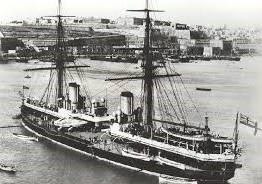
HMS Inflexible – Kane’s command 1890-91
Another player in the drama of the Apia cyclone was to meet a dramatic end a quarter century later. A young midshipman on the Calliope, Horace Lambert Alexander Hood, was to die as a Rear-Admiral on HMS Invincible, the first battle cruiser, at the Battle of Jutland in 1916 when she blew up with the loss of all but six of her crew of 1,032 officers and men. HMS Calliope herself was to survive, near Newcastle, as a moored training ship for Royal Navy Volunteer Reservists until 1951.
What about the Samoan Civil War? It dragged on for years though it never brought the United States and Germany close to war again. The final outcome was the annexation of East Samoa by the United States and of West Samoa to the Germans – which they were to lose to British Empire forces in 1914.
The Dawlish Chronicles – naval fiction set at the apogee of the British Empire
The last chronologically (so far) of the eight novels of the Dawlish Chronicles series, Britannia’s Gamble, can be read as a stand-alone. It is set against the background of one of the most spectacular and memorable events of the late 19th Century and involves one of its best admired real-life personalities.
It’s 1884 and a fanatical revolt, the ISIS of its time, is sweeping all before it in the vast wastes of the Sudan and establishing a rule of persecution and terror. Only the city of Khartoum holds out, its defence masterminded by a British national hero, General Charles Gordon. His position is weakening by the day and a relief force, crawling up the Nile from Egypt, may not reach him in time to avert disaster.
But there is one other way of reaching Gordon…
A boyhood memory leaves the ambitious Royal Navy officer Nicholas Dawlish no option but to attempt it. The obstacles are daunting – barren mountains and parched deserts, tribal rivalries and merciless enemies – and this even before reaching the river that is key to the mission. Dawlish knows that every mile will be contested and that the siege at Khartoum is quickly moving towards its bloody climax.
Outnumbered and isolated, with only ingenuity, courage and fierce allies to sustain them, with safety in Egypt far beyond the Nile’s raging cataracts, Dawlish and his mixed force face brutal conflict on land and water as the Sudan descends into ever-worsening savagery.
And for Dawlish himself, one unexpected and tragic event will change his life forever…
From one of 75 reviews on Amazon.com: Once again Vanner tells a great story really well. His attention to detail is meticulous. His weaving of fact and fiction is seamless. His portrayal of actual events and real people sets a perfect stage for his narrative, and his characters are finely drawn and believable. And his recreation of military action are thrilling. I love the way Vanner fact-checks his stories, and I love the epilogue at the end which follows the lives of actual people he portrays in his story, and also gives some historical context. This is historical fiction done extremely well.
The Dawlish Chronicles – now up to eight volumes, and counting …
Six free short-stories are available for download to your Kindle. Access them by registering for the Dawlish Chronicles mailing list – just click on the banner below. You’ll be kept updated on new books and will receive other free stories at intervals.

